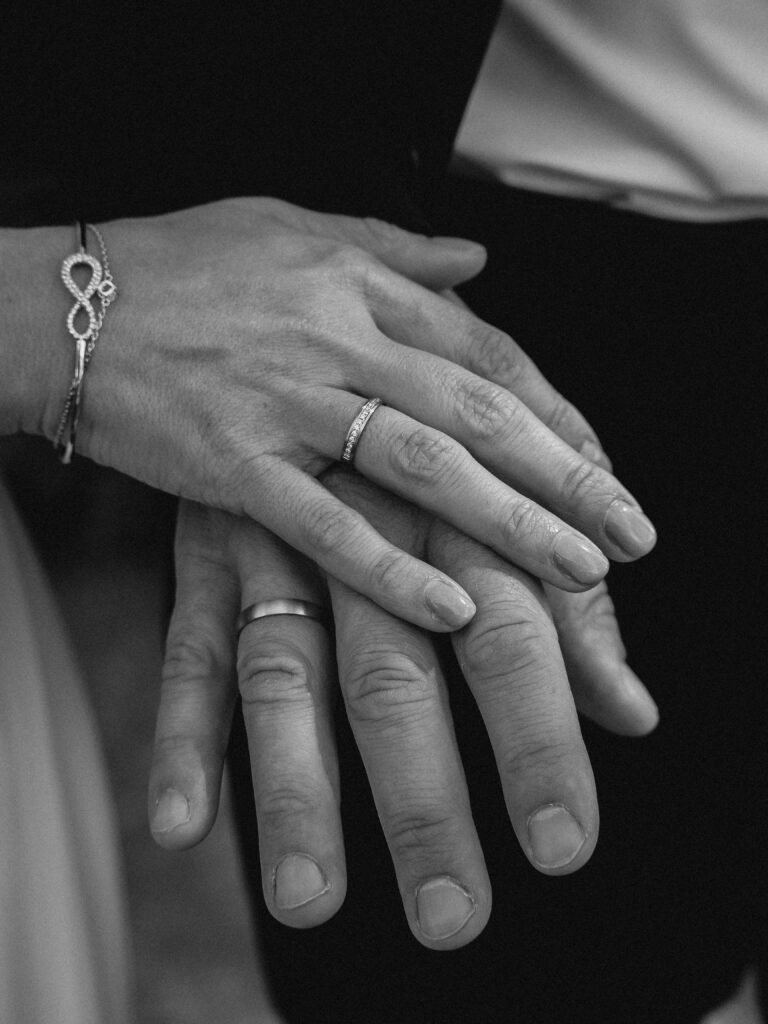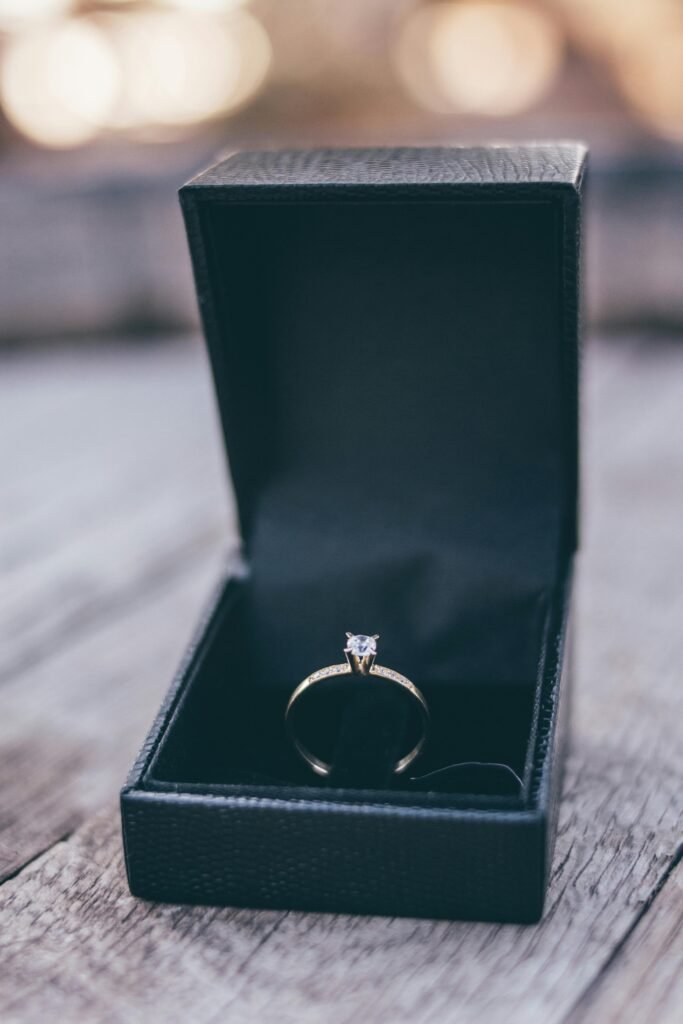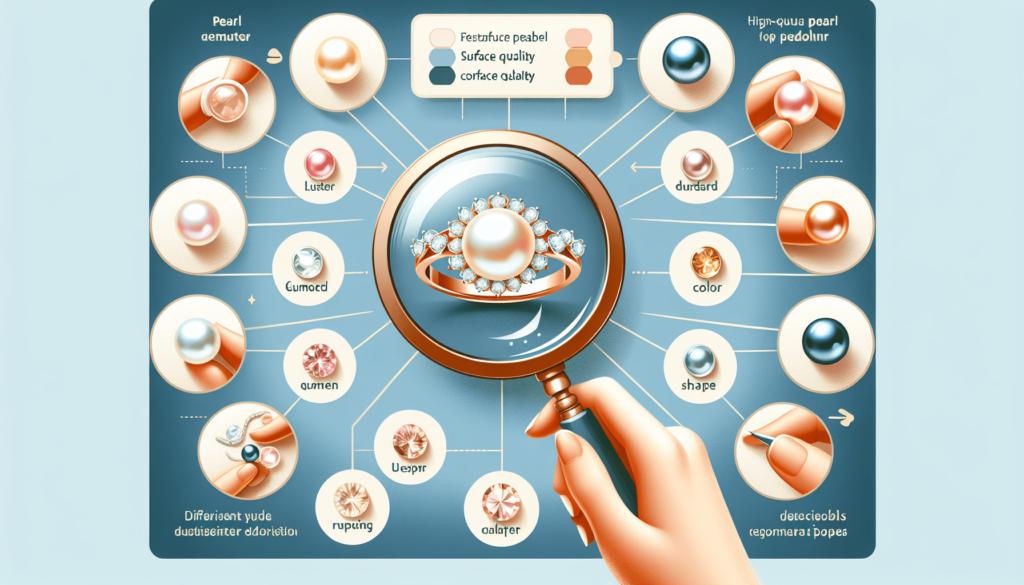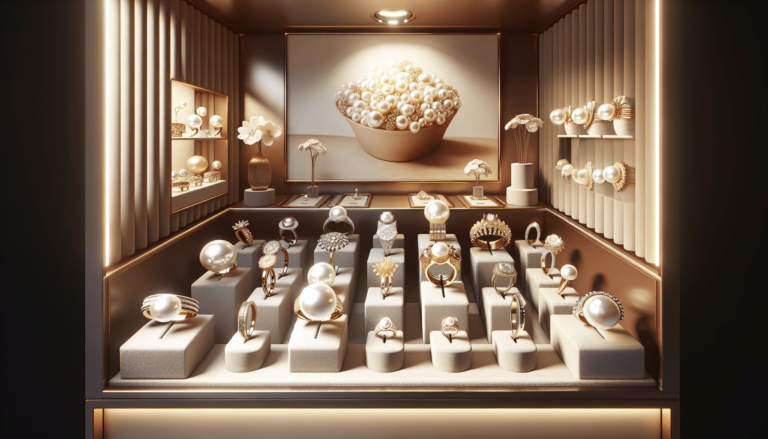When it comes to purchasing a pearl ring, there are certain key indicators that can help you identify a high-quality piece. From the luster and surface quality of the pearl to the durability and craftsmanship of the ring setting, paying attention to these factors will ensure that you make a smart investment in a stunning piece of jewelry. Whether you are a first-time buyer or a seasoned collector, understanding these key indicators will guide you towards finding the perfect pearl ring that will dazzle for years to come.

Find more products like these on Amazon!
Luster
The importance of luster
Luster is an important characteristic to consider when evaluating the quality of a pearl ring. Luster refers to the way light reflects off the surface of the pearl, creating a luminous and iridescent glow. It is often described as the “inner glow” of the pearl. High-quality pearls have a bright, mirror-like luster that is highly prized by pearl enthusiasts. The luster of a pearl is what gives it its allure and elegance, and can greatly impact the overall appearance of a pearl ring.
How to assess luster
Assessing the luster of a pearl is fairly straightforward. Simply hold the pearl up to a source of light and observe how the light reflects off its surface. A pearl with high luster will reflect light evenly and intensely, creating a dazzling glow. On the other hand, pearls with low luster may appear dull and lackluster. When assessing luster, it is important to consider the consistency and intensity of the pearl’s reflection. The higher the luster, the more valuable and desirable the pearl ring will be.
High-quality luster characteristics
High-quality pearls exhibit certain characteristics when it comes to luster. These include a bright and radiant glow, a mirror-like reflection, and a crisp and clear appearance. The reflection should be sharp and well-defined, without any blurry or hazy areas. Additionally, the luster should be consistent throughout the surface of the pearl, without any dull spots or blemishes. Pearls with high-quality luster are often considered the pinnacle of elegance and sophistication, making them highly sought after in the world of pearl jewelry.
Color
Desirable pearl ring colors
The color of a pearl can greatly influence its overall beauty and value. While white and cream-colored pearls are the most traditional and classic choices for pearl rings, there are a wide range of desirable colors to choose from. These can include shades of pink, lavender, blue, green, and even black. Each color possesses its own unique charm and appeal, allowing for a variety of stunning and eye-catching pearl ring designs. When selecting a pearl ring, consider the color that best complements your personal style and preferences.
Factors affecting color
There are several factors that can affect the color of a pearl. One of the most important factors is the type of mollusk that produced the pearl. Different species of mollusks produce pearls with different natural colors. Another factor is the environment in which the pearl was formed. Water quality, temperature, and other environmental factors can all influence the color of a pearl. Additionally, the presence of any impurities or minerals in the water can also affect the color of the pearl. These factors combined create a vast array of pearl colors, each with its own unique characteristics.
Tips for evaluating color
When evaluating the color of a pearl, it is important to consider three main factors: hue, tone, and saturation. Hue refers to the dominant color of the pearl, such as white, pink, or black. Tone refers to the lightness or darkness of the color, with lighter tones often being more valued. Saturation, on the other hand, refers to the intensity or vividness of the color. Highly saturated pearls are generally more desirable. It is also important to consider the overall consistency and uniformity of the pearl’s color. A pearl with even and consistent color throughout is considered of higher quality.

Find more products like these on Amazon!
Shape
Common pearl ring shapes
Pearls come in a variety of shapes, each with its own unique characteristics and visual appeal. Some of the most common pearl shapes used in pearl rings include round, oval, drop, button, and baroque. Round pearls, with their perfectly spherical shape, are often considered the most classic and traditional choice for a pearl ring. Oval pearls offer a sleek and elongated silhouette, while drop pearls have a teardrop-like shape that exudes elegance. Button pearls, as the name suggests, have a slightly flattened shape and are popular for their versatility. Baroque pearls, with their irregular and organic shapes, create a distinctive and artistic look.
How shape affects quality
The shape of a pearl can greatly impact its overall quality and market value. Round pearls are generally considered the most desirable and valuable, as they require precise cultivation techniques and are rarer to find in nature. Pearls with symmetrical and regular shapes also tend to be more highly valued, as they are more difficult to cultivate. However, it is important to note that the impact of shape on quality largely depends on personal preferences and the intended design of the pearl ring. Some may prefer the uniqueness and character of baroque pearls, while others may prefer the timeless elegance of round pearls.
Popular shapes for high-quality rings
When it comes to high-quality pearl rings, certain shapes are often preferred for their classic beauty and elegance. Round pearls, as mentioned earlier, are a top choice for their perfect symmetry and iconic look. Oval pearls are also highly popular, as they offer a balance between sophistication and versatility. Their elongated shape can create a flattering and slimming effect when worn on the finger. Drop pearls are another favored choice, particularly for those seeking a more romantic and feminine look. These shapes, along with other symmetrical and regular shapes, are often associated with high-quality pearl rings.
Size
Varied pearl ring sizes
Pearls come in a wide range of sizes, from delicate seed pearls to more substantial and eye-catching pieces. The size of a pearl can greatly impact its overall appearance and perceived value. Smaller pearls, such as seed pearls, are often used to create delicate and intricate designs, while larger pearls make a bold and statement-worthy centerpiece for a ring. The size of the pearl you choose for your ring largely depends on your personal style, the intended design of the ring, and your budget.
Determining the ideal size
Determining the ideal size of a pearl for your ring is a matter of personal preference and style. Consider the overall design of the ring and how the pearl will be showcased within it. If you prefer a dainty and understated look, smaller pearls may be the best choice. On the other hand, if you want a ring that commands attention and makes a statement, larger pearls may be more suitable. It is also important to consider the size of your finger and how the pearl will proportionally fit on it. Ultimately, the ideal size of a pearl is subjective and should reflect your individual taste and style.
Size considerations for high-quality pearls
When it comes to high-quality pearls, size is often a significant factor to consider. Larger pearls are generally more valuable and highly sought after, as they are less common and require more time to cultivate. However, it is essential to ensure that the size of the pearl is proportionate to its overall quality and other characteristics. A high-quality pearl should possess not only an impressive size but also excellent luster, color, shape, and surface quality. It is the combination of all these factors that truly determines the value and desirability of a pearl ring.

Surface
Assessing surface quality
Assessing the surface quality of a pearl is crucial to determine its overall value and aesthetic appeal. The surface of a pearl should be smooth, clean, and free from any visible blemishes or imperfections. Small surface blemishes, such as spots, pits, or scratches, can significantly diminish the value and beauty of a pearl. When evaluating the surface quality, it is important to carefully observe the pearl under good lighting and from different angles to ensure a thorough inspection.
Common surface characteristics
Pearls, being organic gems, can exhibit various surface characteristics. These can include small dimples, growth lines, or ridges, known as “nacreous growth.” While these features can be natural and add to the pearl’s uniqueness, excessive surface imperfections can detract from its overall beauty and impact its value. Common surface characteristics to watch out for include spots, blemishes, cracks, or uneven textures. Pearls with a smooth and clean surface are generally considered of higher quality and are more desirable in pearl ring designs.
Impacts of surface imperfections
Surface imperfections can have a significant impact on the value and desirability of a pearl ring. Pearls with flawless surfaces, known as “clean” pearls, are highly valued and sought after. These pearls have a smooth and pristine appearance, free from any visible flaws or blemishes. On the other hand, pearls with noticeable surface imperfections may be considered of lower quality and may have a lower market value. While minor blemishes may not necessarily affect the durability or longevity of the pearl, they can detract from its overall aesthetic appeal.
Nacre Thickness
What is nacre thickness
Nacre thickness refers to the layer of mother-of-pearl that coats the surface of a pearl. It is the result of the gradual accumulation of crystalline layers within the pearl, and it gives pearls their distinctive luster and shine. The thickness of the nacre can greatly affect both the durability and the overall quality of a pearl. Thicker nacre generally implies a healthier and stronger pearl, while thinner nacre may make the pearl more susceptible to damage or deterioration over time.
Significance of nacre
Nacre is a significant characteristic to consider when evaluating the quality of a pearl ring. Thicker nacre tends to be more durable and less prone to wear and tear. It also enhances the overall luster and iridescence of the pearl, creating a more captivating and beautiful appearance. Pearls with thicker nacre are often considered of higher quality and are highly valued by pearl collectors and enthusiasts. Nacre quality is a testament to the pearl’s health and cultivation conditions, making it an important indicator of a pearl’s intrinsic value and longevity.
How to determine nacre thickness
Determining the thickness of nacre is not something that can be done visually, as it requires specialized tools and equipment. It requires a process known as x-raying, which allows for a precise measurement of the nacre thickness. However, when purchasing a pearl ring, it is important to inquire about the nacre thickness from a reputable jeweler or seller. They should be able to provide information regarding the quality and thickness of the pearls used in the ring. Understanding the nacre thickness can give you valuable insights into the overall quality and durability of the pearl ring you are considering.

Setting Quality
Different types of settings
The setting of a pearl ring plays a crucial role in both its overall aesthetics and its ability to securely hold the pearl in place. There are various types of settings commonly used for pearl rings, including prong setting, bezel setting, and flush setting. Prong setting is a popular choice as it allows for maximum visibility of the pearl, with metal prongs securely holding the pearl in place. Bezel setting, on the other hand, completely surrounds the pearl with a metal band, providing added protection and security. Flush setting involves embedding the pearl into the surface of the ring, creating a seamless and sleek look.
Importance of a secure setting
A secure setting is essential for ensuring the longevity and durability of a pearl ring. It prevents the pearl from becoming loose or dislodged during daily wear and protects it from potential damage or loss. A well-crafted and sturdy setting will keep the pearl securely in place while allowing it to be showcased to its fullest potential. A loose or poorly made setting can not only compromise the appearance of the pearl ring but also put the pearl at risk of falling out or becoming damaged. When evaluating the quality of a pearl ring, pay close attention to the setting and ensure that it is secure and well-crafted.
How to evaluate setting quality
When assessing the quality of a pearl ring setting, there are several factors to consider. First and foremost, examine the overall craftsmanship and finish of the setting. The metal should be smooth, with no visible rough edges or imperfections. Next, check the strength and security of the setting by gently wiggling the pearl. It should feel snug and firmly held in place. Finally, consider the design and aesthetic appeal of the setting. It should complement the beauty of the pearl and enhance its overall appearance. A high-quality setting will not only protect the pearl but also elevate the overall quality and desirability of the pearl ring.
Cultivation Method
Types of pearl cultivation methods
Pearls can be cultivated using various methods, each with its own unique characteristics and implications for pearl quality. The two most common methods of pearl cultivation are freshwater cultivation and saltwater cultivation. Freshwater pearls are grown in freshwater lakes and rivers, typically in mollusks known as mussels. Saltwater pearls, on the other hand, are cultivated in saltwater environments, usually in oysters. Both methods have their own advantages and disadvantages, and the choice of cultivation method can greatly impact the quality and value of the pearls produced.
Effects on pearl quality
The cultivation method used can significantly affect the overall quality of the pearls. Freshwater pearls, for example, are typically less expensive and more readily available compared to saltwater pearls. They often come in a variety of shapes, sizes, and colors, making them versatile and accessible options for pearl rings. Saltwater pearls, on the other hand, tend to be more valuable and coveted due to their superior luster and overall quality. They are renowned for their round shape, exceptional luster, and exquisite beauty. The cultivation method chosen for a pearl ring can greatly influence its perceived value and desirability.
Choosing the right cultivation method
When selecting a pearl ring, it is essential to consider the cultivation method used and understand its implications for the overall quality and value of the pearls. Freshwater pearls are a great choice for those seeking more affordable options and a wide variety of shapes and colors. They can offer stunning designs and styles without breaking the bank. Saltwater pearls, on the other hand, are ideal for those who value exceptional luster, round shape, and superior quality. Carefully consider your personal preferences, budget, and desired aesthetic when choosing between freshwater and saltwater pearls for your pearl ring.

Brand Reputation
Influential pearl ring brands
When it comes to purchasing a high-quality pearl ring, considering the reputation of the brand is crucial. There are several influential pearl ring brands known for their exceptional craftsmanship, attention to detail, and commitment to using fine quality pearls. Some notable pearl ring brands include Mikimoto, The Pearl Source, Bvlgari, Tiffany & Co., and Pearl Paradise. These brands have established themselves as leaders in the world of pearl jewelry, consistently delivering exquisite pearl rings that are synonymous with luxury and elegance.
Importance of brand reputation
The reputation of a brand speaks volumes about the quality and authenticity of their pearl rings. Established and reputable brands have built their success on years of expertise, craftsmanship, and dedication to sourcing and producing the finest quality pearls. They adhere to strict quality standards and often provide certificates of authenticity and grading for their pearls. Choosing a reputable brand ensures that the pearl ring you purchase is genuine, well-crafted, and made with high-quality materials. It gives you confidence in your purchase and assurance that you are investing in a piece of jewelry that will endure the test of time.
Researching brand reputation
Before making a purchase, it is important to conduct thorough research on the reputation and credibility of the brand. Start by reading customer reviews and testimonials to gauge the level of customer satisfaction and the overall quality of their products. Look for certifications or awards that the brand has received, as these can testify to their commitment to excellence. Also, consider the brand’s history and legacy, as well as any associations or collaborations they may have had in the industry. By investing time in researching the reputation of the brand, you can ensure that you are making an informed decision and selecting a pearl ring from a reputable and trusted source.
Price vs. Quality
Determining a fair price
Determining the fair price of a pearl ring requires consideration of various factors, including the quality of the pearls, the craftsmanship of the setting, the brand reputation, and the current market trends. High-quality pearl rings often command a higher price due to the rarity and desirability of the pearls used, as well as the expertise and craftsmanship involved in creating the ring. However, it is essential to strike a balance between price and quality, ensuring that you are getting a fair value for your investment. Compare prices across different brands and jewelers, and always consider the intrinsic value and quality of the pearl ring before making a decision.
Factors affecting pricing
Several factors can influence the pricing of a pearl ring. The first and most significant factor is the quality of the pearls used. The higher the quality in terms of luster, color, shape, and surface characteristics, the higher the price. The type of metal used in the setting can also impact the price, with precious metals such as gold or platinum being more expensive. Another factor to consider is the brand reputation, as renowned brands often come with a higher price due to their reputation and craftsmanship. Finally, market trends and supply and demand can influence pricing, with rare or limited-edition pearl rings often commanding a higher price.
Balancing price and quality
Balancing price and quality is essential when purchasing a pearl ring. While it can be tempting to go for the most expensive option assuming it is of the highest quality, it is crucial to evaluate the overall value and quality of the pearl ring. Consider the characteristics of the pearls, such as luster, color, shape, and surface quality, in relation to the price. Assess the craftsmanship of the setting and ensure it meets your standards in terms of quality and durability. By carefully evaluating both price and quality, you can find a pearl ring that offers excellent value and represents a wise investment in terms of both beauty and longevity.
In conclusion, assessing the quality of a pearl ring involves considering various key indicators. Luster, color, shape, size, surface quality, nacre thickness, setting quality, cultivation method, brand reputation, price, and quality are all vital factors to evaluate when selecting a pearl ring. By understanding and appreciating these indicators, you can make an informed decision and find a high-quality pearl ring that reflects your personal style and will be cherished for years to come. Whether you are a seasoned pearl enthusiast or a first-time buyer, the comprehensive understanding of these indicators will guide you in finding the perfect pearl ring that exudes elegance, sophistication, and timeless beauty.




